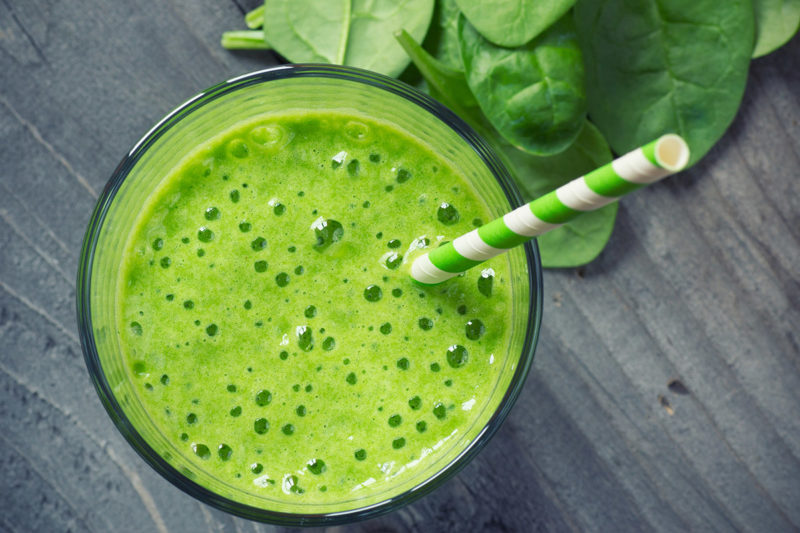In this ongoing series, the Levels team takes a close look at fast-food chains and restaurants to help you find the most metabolically friendly options. Read on for guidance on maximizing nutrition and maintaining healthy blood sugar levels when dining out.
A stop at the smoothie shop seems like a healthy choice. After all, you’ll sip down a boatload of fiber– and antioxidant-rich fruits and vegetables, plus healthy additions such as Greek yogurt and protein powder.
But don’t let the marketing of these chains fool you: Many smoothies can be problematic for blood glucose. Even though fruits and veggies themselves are healthy, pulverizing large quantities of them can pack a massive amount of sugar into one drink while also decreasing fiber. When mixed with other sweetened ingredients—such as frozen yogurt and honey—some smoothies can serve up more sugar than an ice cream sundae.
That doesn’t mean you need to steer clear, though. By understanding the menu and choosing the right ingredients, you can grab a smart on-the-go meal or snack that will fill you up and keep your blood sugar steady.
The Metabolic Challenge at a Smoothie Shop
You probably wouldn’t polish off five-plus servings of fruit in one sitting. But many smoothies squeeze that amount into one portion, and the sugar shock can be staggering: One medium 22-ounce Watermelon Breeze smoothie at Jamba Juice packs 85 grams of sugar, while the same size Mahalo Mango at Robeks delivers 74 grams. That’s the same amount of sugar you’d get drinking two 12-ounce cans of soda.
Fruit contains two kinds of simple sugars: glucose and fructose.
- Glucose is the primary sugar in your bloodstream. When you get a large dose of glucose at once, your blood sugar can rise quickly and then fall quickly, causing an energy surge and crash. Over the long run, too-high blood sugar levels can set the stage for insulin resistance and diabetes.
- Fructose is broken down in the liver. When you consume too much fructose, over time it can build up as fat in your liver and increase the risk of insulin resistance and metabolic syndrome. Most of the health problems caused by consuming too much fructose come from artificial high-fructose corn syrup found in processed foods.
Most whole fruits and vegetables usually don’t have as big an effect on blood glucose as processed foods because their fiber slows down the entry of glucose into your bloodstream. In fact, eating more low-glycemic whole fruit may lower the risk of diabetes, possibly because some whole fruit appears to improve insulin sensitivity.
The problem with smoothies is that their insoluble fiber is chopped up into tiny pieces by a blender. So when you slurp down a smoothie rather than eating fruit, you don’t get the benefit of a slower rise in blood glucose.
In addition to the amount of fruit, another potential problem is the kind of fruits used. Some fruits contain more sugar than others. This is especially true of tropical fruits, which are popular smoothie staples. A cup of mango contains 23 grams of sugar, while a large banana has 17 grams. Compare that to the 5 grams in a cup of raspberries.
Lastly, this fruit is often blended with ingredients that can cause a blood sugar rise. Add-ons often include frozen yogurt, sherbet, honey, agave, or sweetened protein powder. And if these ingredients are blended with a sugary liquid—such as fruit juice or sweetened nut milk—the sugar content in your smoothie can skyrocket.
Fortunately, most smoothie shops offer a make-your-own option, which can help you craft a drink in line with your health goals. The key is having the right ratio of fruits, vegetables, fat, and protein.
Follow the tips below to build a nutritious meal or snack that will keep your blood sugar stable.
8 Steps to a Better Smoothie Order
1. Ask for extra veggies.
Think about your vegetables first when creating your order. You want your smoothie to be heavy on veggies and light on fruit, so ask for an extra serving (or more). You’ll know you hit the mark if your final drink has a green or brownish hue.
Leafy greens, such as spinach and kale, are a smart choice. They’re high in magnesium, which may help keep blood sugar levels in check. Your body uses this mineral to convert glucose into fuel, so if you don’t get enough magnesium, your cells may become less sensitive to insulin. Two cups of raw spinach provide roughly 14 percent of the magnesium you need daily.
2. Look for lower-sugar fruit.
Tropical fruits such as mangoes, bananas, and pineapples tend to be higher in sugar than other options. Smarter choices include raspberries (5 grams per cup), strawberries (7 grams per cup), blackberries (7 grams per cup), and blueberries (10 grams per cup). Whole kiwi (6 grams per fruit) is another smart option. You can also add low-sugar zing to your drink by squeezing in a bit of lemon or lime juice (about 2 grams of sugar per fruit). Whatever you choose, think of fruit as a condiment and add a small amount.
3. Add healthy fat.
Heart-healthy fats can help you stay full longer and boost your metabolic health: Eating more unsaturated fats and fewer carbohydrates improves blood glucose control. Polyunsaturated fats, in particular, appear to promote insulin secretion. So when making a smoothie, add some creamy almond butter (9 grams of fat per tablespoon), peanut butter (8 grams of fat per tablespoon), or ground flaxseed (3 grams of fat per tablespoon). As a bonus, these also provide a little protein. Coconut oil (11.5 grams of fat per tablespoon) is another option that will add a hint of sweet flavor without any sugar.
4. Pick a protein (or two).
Protein can help fend off hunger without raising blood sugar levels. It can also slow the release of glucose into the bloodstream to help stabilize your levels. Plain unsweetened nonfat Greek yogurt serves up 23 grams of protein per cup, and nut butters, flaxseed, and chia seeds are other protein sources. You can also add protein powder but request an unsweetened version.
5. Swap juice for water or milk.
Many smoothie shops use fruit juice, which tacks on extra sugar without much fiber. This can spike your blood sugar. One study found that sipping three half-cup servings of fruit juice a week can raise your risk of diabetes by 8 percent, likely due to fruit juice’s high glycemic load and rapid digestion, which causes more extreme elevations in postprandial blood sugar and insulin in the body.
Better choices: Blend your smoothie with water, coconut water, milk, or unsweetened non-dairy milk. (Double-check that any plant-based milk doesn’t have added sugars; some varieties contain up to 20 grams of sugar per cup.)
6. Create a creamy consistency without added sugars.
Some smoothies start with sherbet, frozen yogurt, or ice cream to add cold creaminess. Even two large frozen bananas can serve upwards of 32 grams of sugar. If you desire that thicker texture, request frozen berries, raw nuts, or a half a banana. Even better, opt for protein-packed Greek yogurt or ask for avocado, which is high in healthy fats.
7. Hold the syrupy stuff.
Although they are considered “natural sugars,” honey, agave, maple syrup, and date syrup add a rush of additional sugar and not enough other nutrients to offset or justify that sugar. Add flavor without sugar by using vanilla bean paste, cocoa powder, or cinnamon.
8. Divvy up the drink.
Chances are, you’ll get multiple servings in one smoothie—some large smoothies deliver 32 ounces (four cups) in one enormous container. Because liquids go down quickly, it’s easy to sip extra calories and sugar in one sitting. Ask the shop to serve your smoothie in two containers, then save one for another day or give it to a friend.
3 Smart Smoothie Orders
For the best blend, build your own smoothie or order off the menu with some customizations. Look for a mix high on veggies, light on fruit, and a good dose of healthy fats, protein, and fiber. Then request an unsweetened liquid.
- If you’re DIY’ing…
…order blueberries, Greek yogurt or unsweetened non-dairy yogurt, kale or spinach, and chia seeds blended with unsweetened almond milk. - If you’re at Jamba Juice…
…order the PB Chocolate Love, a blend of chocolate, banana, protein-rich low-fat dairy milk, and creamy peanut butter (a source of healthy fat). Add kale and chia seeds to boost the fiber and protein. Then request a split cup. - If you’re at Nekter Juice Bar…
…order the Tropical Cooler. This green smoothie combines spinach, kale, pineapple, banana, and hydrating coconut water. To get your protein and fat, add the vanilla pea protein and chia seeds. Then ask for them to divide your smoothie into two cups.
Interested in how CGM can help you improve your metabolic health?
Levels, the health tech company behind this blog, helps people improve their metabolic health by showing how food and lifestyle impact your blood sugar, using continuous glucose monitoring (CGM), along with an app that offers personalized guidance and helps you build healthy habits. Click here to learn more about Levels.








